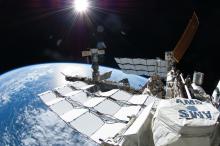Listen to today's episode of StarDate on the web the same day it airs in high-quality streaming audio without any extra ads or announcements. Choose a $8 one-month pass, or listen every day for a year for just $30.
You are here
NICER Scanners
Getting a space telescope ready to fly takes a lot of testing. But there’s no “once-size-fits-all” test rack. In many cases, scientists have to create new equipment just to check things out. And sometimes, that equipment can be adapted for other uses.
Consider NICER, an X-ray telescope that’s been operating aboard the International Space Station since 2017. It studies neutron stars, black holes, and other extreme objects.
One of NICER’s tools is recording extremely fast changes in brightness — as little as millionths of a second. Before it was launched, though, there was no way to produce such quick X-ray flashes for testing. So mission scientists invented their own X-ray machines — small instruments that could produce pulses of a few millionths of a second or longer.
A researcher at Massachusetts General Hospital heard about the new invention, and saw an opportunity. Conventional cat-scan machines are big and heavy, and they have to move around to provide 3D X-rays. But he adapted the NICER test devices to provide a stationary ring. It was smaller than conventional machines, and it could focus its X-rays on areas that doctors really wanted to see. It would require smaller doses of X-rays, and it had the potential to be less expensive.
In early small-scale tests, the new scanner worked well. So today, researchers are scaling it up — looking into the human body with machines designed to look into dead stars.
Script by Damond Benningfield




